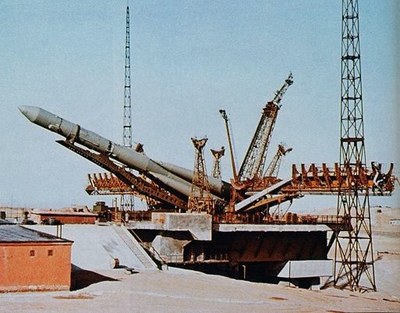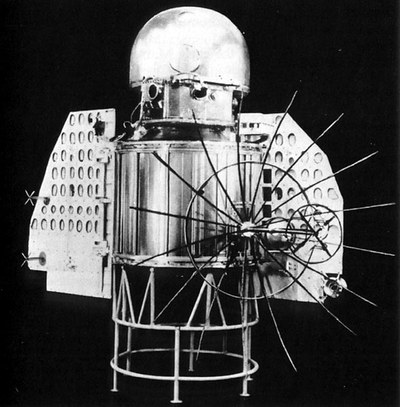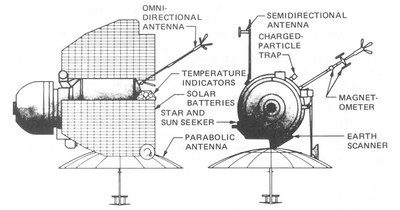The beginnings of planetary exploration: the first probes to Venusby Andrew J. LePage
|
| It was generally believed that the atmospheric pressure at the surface of Venus was around five times that of Earth and that liquid water was likely present on the surface. As a result, engineers at OKB-1 designed their lander to float on a putative Venusian ocean. |
The original intent of Korolev and his team with the first unmanned Venus mission was to attempt a landing. By February of 1960 Korolev’s plans called for not only landing on Venus but also using the 1M to carry landers to Mars as well. Described as being the size of a television set and weighing no more than 285 kilograms (630 pounds), the lander would detach from the main spacecraft and use parachutes to make the final descent to the surface. Through the summer of 1960, models of the landers were carried to altitudes of 50 kilometers (165,000 feet) by R-11A rockets (the sounding rocket version of an early variant of the infamous SS-1 Scud missile). But in the end Korolev’s goal proved too ambitious. The landers for the Mars attempt in October 1960 were abandoned entirely while only a very simple lander without parachutes or other apparent landing aids would be sent to Venus.
The Venus lander carried by the 1VA was a hemisphere about a meter (40 inches) across covered by what was described as a “thermal cover”, which was intended to protect the craft during descent. At this time the properties of the Venusian atmosphere and its surface were unknown. It was generally believed that the atmospheric pressure at the surface of Venus was around five times that of Earth and that liquid water was likely present on the surface. As a result, engineers at OKB-1 designed their lander to float on a putative Venusian ocean. The lander carried a “phase state sensor” that would detect any motion of the lander once it touched down on Venus. If the lander settled in a large body of water, this sensor could detect its bobbing motion from the waves. Also carried were some commemorative items: a disk with the Soviet coat of arms on one side and a diagram of the solar system on the other, placed inside of a pressurized metal globe of the Earth 7 centimeters (2.8 inches) in diameter that itself was design to float.
The lander was mounted on the top of the main body of the 1VA. It was a cylinder 105 centimeters (41.3 inches) across that stood 203.5 centimeters (80.1 inches) tall with the lander attached. The interior of the main body, like the lander, was pressurized to about 1.2 atmospheres to provide a relatively benign laboratory-like environment for most of the spacecraft’s equipment. Thermal control to maintain an internal temperature of about 30˚ C (86˚ F) was provided by a system of louvers similar to that employed by Luna 3 that photographed the far side of the Moon in October 1959. Power to recharge the probe’s batteries was provided by a pair of solar panels, each with dimensions of about 1 by 1.6 meters (3.3 by 4.2 feet) with a total area of about two square meters (22 square feet). The 1VA carried a suite of instruments similar to that included on the 1M probes to characterize the particle and field environment at Venus as well as during the interplanetary cruise.
The 1VA was three-axis stabilized using a system based on that successfully used by Luna 3. A set of Sun and star sensors along with gyroscopes were used to sense the spacecraft’s orientation with compressed nitrogen jets providing attitude control. While contemporary diagrams and descriptions of the 1VA did not show it, the spacecraft carried a propulsion module to provide a mid-course correction capability. It was powered by a KDU-414 engine developed at OKB-2 headed by Alexei Isayev. It generated two kilonewtons (440 pounds-force) of thrust burning the hypergolic propellants unsymmetrical dimethyl hydrazine and nitric acid. This propulsion module would be jettisoned sometime before the encounter with Venus when it was no longer needed.
| Earth orbit was as far as the first 1VA would travel. |
Despite the midcourse correction capability, it was unlikely that the 1VA would actually hit Venus as intended given the early state of interplanetary navigation and the relatively imprecise knowledge of the exact value of the Astronomical Unit (i.e. the mean distance of the Earth from the Sun) at that time. But even if this lander made it to Venus and somehow survived entry into its atmosphere despite the primitive nature of its “thermal cover”, it still would have never reached the surface intact. The lander would have been crushed during descent tens of kilometers above the surface because the scientists of the time were underestimating the true density of Venusian atmosphere by over an order of magnitude.
The 1VA carried three sets of antennas for communications with the Earth. An omni-directional antenna 2.4 meters (7.9 feet) long provided communications at a wavelength of 1.6 meters during the early stages of the mission. A T-shaped antenna deployed after leaving the vicinity of the Earth transmitted at a frequency of 922.8 MHz at a data rate of one bit per second. As the 1VA approached Venus, a wire-mesh dish antenna two meters (6.6 feet) in diameter would be deployed to transmit data at wavelengths of 8 and 32 centimeters. Commands were uplinked to the spacecraft at 1.6 bits per second using a receiver tuned to 770 MHz. During the early stages of the mission, the 1VA would be contacted every day or two but during the interplanetary cruise the time between communication sessions was typically five days. The intervals were controlled by an onboard timer set by ground command.
 An early version of the 8K78 launch vehicle being erected on its launch pad. (credit: RKK Energia) |
The missions
The first 1VA was shipped to the Baikonur Cosmodrome in Soviet Kazakhstan on January 1, 1961, with its 8K78 launch vehicle arriving on January 5. Just as happened with the 1M Mars spacecraft, the launch of the 1VA was delayed as a host of problems were encountered during its final assembly, testing, and integration with the launch vehicle. Design flaws, coupled with the fact that many factory tests of the 1VA spacecraft were skipped in order to get the hardware delivered in time for the limited launch window, did not help.
After weeks of delays, 1VA number 1 mounted atop of 8K78 number L1-6 was rolled out to the launch pad on the morning of February 1, 1961. Finally, on the night of February 4, the first probe to Venus lifted off. Unlike the pair of launches of the 1M the previous October, the Blok I third stage of the 8K78 operated successfully, placing the Blok L escape stage and its 1VA payload into a parking orbit of 224 by 328 kilometers (139 by 204 miles) inclined 65 degrees to the equator. With a reported mass of 6,483 kilograms (14,276 pounds), this was the heaviest object placed into orbit up to this point in the Space Age.
But Earth orbit was as far as the first 1VA would travel. A power supply failure caused by a previously unrecognized design flaw in the Blok L control system prevented the stage from igniting, stranding the spacecraft in Earth orbit. Designated Tyzhuli Sputnik 4 (Russian for “Heavy Satellite 4”—the first three were the successful Luna probes) by the Soviets or inaccurately as Sputnik 7 in the West, Soviet authorities claimed that the purpose of this flight was simply to address issues with orbiting heavy payloads and that its mission was successfully completed after one orbit. Western observers were unconvinced. While rumors of a failed attempt to orbit a cosmonaut circulated widely in the European press, it was generally suspected almost from the start that this was a failed attempt to reach Venus. The orbit of Tyzhuli Sputnik 4 decayed over the coming days and finally fell to Earth on February 26. Two years later debris from 1VA number 1, including the commemorative disk, was found by a young boy near the River Baryusha in Siberia.
| But as Venera continued into interplanetary space, things began to go wrong. |
The cause of the Blok L power supply failure was quickly identified and a temporary fix implemented. On February 11, 1961, 1VA number 2 mounted atop 8K78 number L1-7 was rolled out to the launch pad. The second 1VA lifted off at 7:04:35 am Moscow Time on February 12 with only three days left in the Venus launch window. As before, the first three stages of the 8K78 operated as intended, placing Tyzhuli Sputnik 5, with a mass of 6,475 kilograms (14,258 pounds), into a parking orbit of 198 by 319 kilometers (123 by 198 miles) inclined 65 degrees to the equator. But unlike its predecessor, the Blok L escape stage came to life on schedule and successfully injected the 643.5-kilogram (1,417-pound) 1VA into a trajectory towards Venus. The Soviets designated this probe their second Automated Interplanetary Station (the first was Luna 3). Only years later, after more probes were launched by the Soviet Union to Venus, would this 1VA be referred to as Venera 1.
The first communications session with Venera 1 was held later on launch day when the quickly receding probe was already 126,300 kilometers (78,500 miles) from the Earth. A second session was held on February 13 at a distance of 488,900 kilometers (303,900 miles). Tracking showed that Venera 1 would miss Venus by 100,000 kilometers (60,000 miles) on May 19 if its course was not corrected—an excellent shot for the first successful 8K78 flight given the 270 million kilometers (168 million miles) Venera 1 would have to travel. Data from the scientific instruments were returned providing information on the solar wind.
But as Venera continued into interplanetary space, things began to go wrong. The thermal control system was proving to be inadequate for the task. The Sun sensor, which was not inside the pressurized spacecraft body, was overheating and as a result not functioning properly. To get around the problem, Venera was set spinning slowly along its Sun-pointing axis to keep the solar panels illuminated. Only when the timer was tripped would the spacecraft stabilize its attitude on all three axes and orient itself to contact controllers back on the Earth. In between communication sessions the probe’s receiver along with most of the other onboard equipment was turned off. To the relief of ground controllers, the third communication session successfully took place as programmed on February 17 at a range of 1.889 million kilometers (1.174 million miles).
 A view of the Venera 1 spacecraft launched on February 12, 1961. (credit: NASA) |
On February 22, when Venera 1 was 3.2 million kilometers (2.0 million miles) from the Earth, controllers sent commands to the spacecraft that were apparently acknowledged, but no engineering or scientific data were returned. During the communication session scheduled five days later, Venera’s high frequency transmitter did not respond properly and transmission fadeouts were reported. A communication session scheduled for March 4 at a range of 7.5 million kilometers (4.7 million miles) failed entirely. Venera 1 was never heard from again. Not only did the Soviet probe fail to operate all the way to Venus, it did not even break the communication distance record of 36.2 million kilometers (22.5 million miles) set eight months earlier by the American interplanetary probe, Pioneer 5.
An investigation into the failure was immediately started. Publically, Soviet officials stated rather ominously that sabotage during assembly of the 1VA could not be excluded. It is not known if a saboteur was ever prosecuted, but engineers at OKB-1 found a much more mundane cause for the failure: a malfunction in Venera’s timer. Hoping to salvage the mission, the Soviets enlisted the help of the radio observatory at Jodrell Bank near Manchester, England. The 76-meter (250-foot) dish antenna (now known as the Lovell Observatory) located there had been used to monitor the first Soviet Luna probes in 1959 and it was hoped that they might have better luck contacting Venera 1. They did not.
On May 17, as Venera approached Venus and was expected to deploy its dish antenna, the Soviet tracking station at Yevpatoria in the Crimea sent commands towards the spacecraft in a last ditch effort to activate it in time for the flyby. Again, nothing was heard by either the Soviet tracking station or Jodrell Bank. Attempts to contact Venera 1 from Jodrell Bank with the direct assistance of Soviet engineers continued until June 20, 1961, with no luck.
The Soviet Venus missions were not a total loss. While the 1VA failed to return any data from Venus, it was the first object successfully launched towards another planet. Engineers at OKB-1 also learned many lessons from the flight that was applied to future missions. Valuable experience was gained with the 8K78 and additional improvements were in the works to enhance the launch vehicle’s reliability and performance. Changes to interplanetary spacecraft design were also identified. The spacecraft timer was totally redesigned along with its thermal control system. In the future the spacecraft receiver would also be left on to allow ground controllers to contact the spacecraft even between scheduled communication sessions. These and many more improvements would be incorporated into the next generation of probes to be launched to Venus in August of 1962. But this time the Soviet Union would have competition from the American Mariner A spacecraft already under development.
Bibliography
Boris Chertok, Rockets and People Volume II: Creating a Rocket Industry (SP-2006-4110), NASA History Division, 2006
Brian Harvey, Russian Planetary Exploration: History, Development, Legacy and Prospects, Springer-Praxis, 2007
Nicholas L. Johnson, Handbook of Soviet Lunar and Planetary Exploration, Univelt, 1979
Robert Reeves, The Superpower Space Race: An Explosive Rivalry Through the Solar System, Plenum Press, 1994
Timothy Varfolomeyev, “The Soviet Venus Program”, Spaceflight, Vol. 35, No. 2, pp 42–43, February 1993
Timothy Varfolomeyev, “Soviet Rocketry that Conquered Space – Part 4: The Development of a Four-Stage Launcher, 1958–1960”, Spaceflight, Vol. 40, No. 1, pp 28–30, January 1998
Timothy Varfolomeyev, “Soviet Rocketry that Conquered Space – Part 5: The First Planetary Attempts, 1960–1964”, Spaceflight, Vol. 40, No. 3, pp 85–88, March 1998
